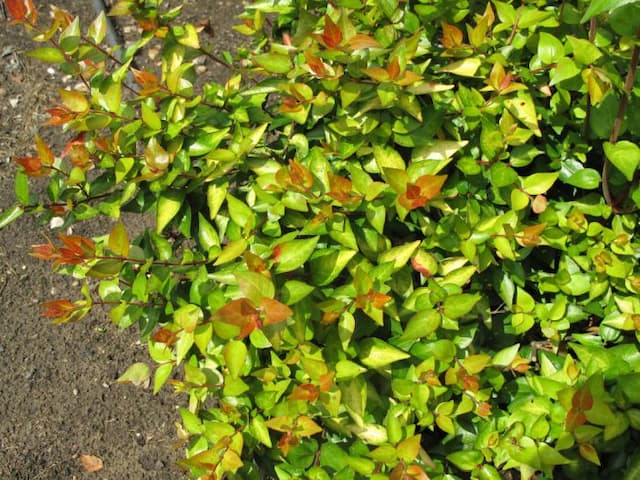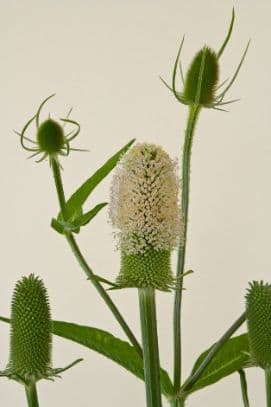Honeysuckle Lonicera periclymenum 'Rhubarb and Custard'
ABOUT
The Lonicera periclymenum 'Rhubarb and Custard', commonly known as Honeysuckle, is a notably attractive plant that catches many an eye in the garden. It is appreciated for its colorful and fragrant flowers, which tend to resemble trumpet shapes. These blossom in a captivating blend of colors, featuring creamy yellow on the inside and flushed with a variable pinkish-red hue on the outer side. The juxtaposition of these colors gives the flowers an appearance reminiscent of rhubarb and custard, which is where the cultivar gets its memorable name. The flowers emerge from pinkish-red buds that provide ornamental value even before they unfurl. As they open, they reveal their tubular form which is elongated and appears in whorls spaced along the upper parts of stems. The plant's foliage is also worth mentioning, with leaves that sport a deep green color and an oval to elliptical shape, providing a lush backdrop for the brightly hued flowers. These blossoms are not only visually appealing; they also emit a sweet and heavy fragrance that is particularly noticeable in the evening and night, making it a favorite for those who enjoy aromatic gardens. This scent attracts a variety of pollinators, including bees, butterflies, and hummingbirds. After the flowering period, the Honeysuckle may produce small red berries, although these are not edible for humans, they can be a food source for birds. Tending to have a twining habit, this Honeysuckle plant is a climber, often used to adorn fences, walls, trellises, or arbors, where its vines can wind their way upwards, creating a tapestry of color and scent. While the dimensions of the plant cannot be specifically mentioned, the Honeysuckle 'Rhubarb and Custard' can create a significant presence in the appropriate setting, making an impact through both its visual beauty and its delightful perfume.
About this plant
 Names
NamesFamily
Caprifoliaceae
Synonyms
Honeysuckle, Woodbine, Rhubarb and Custard Honeysuckle
Common names
Lonicera periclymenum 'Rhubarb and Custard'.
 Toxicity
ToxicityTo humans
Honeysuckle is generally considered non-toxic to humans, but it should be noted that some species contain saponins and glycosides which can be harmful if ingested in large quantities. Symptoms of honeysuckle poisoning might include stomach upset, diarrhea, and vomiting. It is advisable to avoid eating parts of honeysuckle plants, particularly in large amounts, due to the potential for toxic effects.
To pets
Honeysuckle can be toxic to pets, especially dogs and cats, if ingested. The most common symptoms of honeysuckle poisoning in pets include vomiting, diarrhea, and in severe cases, it can lead to depression. Ingesting honeysuckle can result in gastrointestinal upset for pets, and it is advisable to keep the plant out of reach of pets to prevent any potential harm.
 Characteristics
CharacteristicsLife cycle
Perennials
Foliage type
Deciduous
Color of leaves
Green
Flower color
Mixed
Height
6-15 feet (1.8-4.6 meters)
Spread
6-15 feet (1.8-4.6 meters)
Plant type
Climber
Hardiness zones
5-9
Native area
Europe
Benefits
 General Benefits
General Benefits- Aesthetic Appeal: The Lonicera periclymenum 'Rhubarb and Custard', commonly known as Honeysuckle, exhibits striking variegated foliage and vibrant pink and yellow flowers, providing visual interest in a garden.
- Fragrance: The flowers of the Honeysuckle produce a sweet and pleasant fragrance, which can enhance the sensory experience of a garden or outdoor area.
- Attracts Wildlife: Honeysuckle is known for attracting a variety of wildlife, including bees, butterflies, and hummingbirds, which are beneficial for pollination.
- Long Blooming Period: This plant typically has a long flowering period, which can extend from late spring to late summer, offering prolonged beauty in the landscape.
- Versatility: Honeysuckle can be grown as a climbing vine or ground cover, providing flexibility in garden design and usage in different landscape scenarios.
- Drought Tolerance: Once established, Honeysuckle can be relatively drought-tolerant, requiring less frequent watering compared to some other garden plants.
- Shade Tolerance: Honeysuckle can perform well in partial shade, making it a suitable plant for gardens with varying light conditions.
 Medical Properties
Medical PropertiesThis plant is not used for medical purposes.
 Air-purifying Qualities
Air-purifying QualitiesThis plant is not specifically known for air purifying qualities.
 Other Uses
Other Uses- Lonicera periclymenum 'Rhubarb and Custard', commonly known as Honeysuckle, can be used as a natural dye due to its pigmented foliage and flowers, suitable for coloring fabrics or artwork.
- The twining stems of Honeysuckle are sometimes utilized in basket making for their flexibility and strength once dried.
- The sweet fragrance of Honeysuckle flowers has been historically used to make perfumes and scented oils.
- Trimmed Honeysuckle vines can be repurposed into garden ties or supports for other plants due to their pliability.
- Honeysuckle can serve as a privacy screen when grown densely on fences or trellises, offering a natural barrier.
- Flower buds and nectar can be used to flavor syrups and sweet beverages, contributing a mild honey-like taste.
- The dried flowers and leaves of Honeysuckle can be included in potpourri mixtures for their pleasant scent.
- In landscape design, Honeysuckle can be used to create a living roof on pergolas or arbors, offering shade and ornamental value.
- The plant's fast-growing nature makes it suitable for use in educational projects about plant growth and climbing mechanisms.
- Honeysuckle is traditionally used in crafting natural wreaths or floral arrangements, especially in rustic or country-themed decor.
Interesting Facts
 Feng Shui
Feng ShuiHoneysuckle is not used in Feng Shui practice.
 Zodiac Sign Compitability
Zodiac Sign CompitabilityHoneysuckle is not used in astrology practice.
 Plant Symbolism
Plant Symbolism- Love and Devotion: Honeysuckle, including the variety Lonicera periclymenum 'Rhubarb and Custard', has often been associated with love and the bonds of affection due to its twining growth habit, which suggests a close connection that is hard to break.
- Friendship: The sweet scent and the interconnected nature of the plant’s vines are indicative of strong friendships that are cherished and nurtured over time.
- Happiness: With its delightful fragrance and colorful blooms, honeysuckle is commonly linked to happiness and cheerfulness, bringing a bright disposition to gardens.
- Prosperity: The vigorous growth and resilience of honeysuckle can symbolize prosperity and the ability to thrive in various conditions.
 Water
WaterHoneysuckle 'Rhubarb and Custard' should be watered thoroughly once the top inch of soil feels dry to the touch, which typically means watering once every week during active growing seasons, spring and summer. In the cooler months of fall and winter, reduce watering to every two weeks, ensuring the plant does not sit in waterlogged soil. When you water, do so deeply, using approximately 1 to 2 gallons of water, depending on the size of the plant and the environmental conditions. The goal is to moisten the soil to a depth of at least 6 to 8 inches to encourage deep root growth. Make sure that the plant has good drainage to prevent root rot.
 Light
LightHoneysuckle 'Rhubarb and Custard' thrives best in full sun to partial shade conditions. Ideally, it should receive at least 6 hours of direct sunlight daily, although it can tolerate some afternoon shade, especially in hotter climates. The perfect spot would be where the plant is exposed to morning sunlight and receives dappled light or slight shade during the hottest part of the day.
 Temperature
TemperatureHoneysuckle 'Rhubarb and Custard' is hardy and can withstand temperatures down to about 20 degrees Fahrenheit, making it suitable for many climates. However, it grows best when the temperature ranges between 60 and 80 degrees Fahrenheit. It can also tolerate higher temperatures as long as it's not exposed to prolonged periods above 95 degrees Fahrenheit without adequate water and some shade.
 Pruning
PruningPruning Honeysuckle 'Rhubarb and Custard' is important for maintaining a desirable shape, promoting healthy growth, and encouraging more blooms. Prune lightly in late winter or early spring before the plant begins its active growth. Remove dead or weak branches and shape the plant as desired. Additionally, after flowering, you can prune selectively to encourage new blossoms and to prevent the plant from becoming too dense.
 Cleaning
CleaningAs needed
 Soil
SoilHoneysuckle 'Rhubarb and Custard' prefers well-drained, fertile soil with a pH of 5.5 to 8. A mix of garden soil, compost, and a small amount of sand or perlite would be ideal to ensure good drainage and fertility.
 Repotting
RepottingHoneysuckle 'Rhubarb and Custard' should be repotted every 2-3 years, or when it becomes root-bound. Spring is the best time for repotting to allow the plant to establish in the new soil before the growing season.
 Humidity & Misting
Humidity & MistingHoneysuckle 'Rhubarb and Custard' thrives in moderate humidity levels. While it can tolerate some variation, it prefers a consistent environment that is neither too dry nor excessively humid.
 Suitable locations
Suitable locationsIndoor
Place in bright, indirect light, and ensure good air circulation.
Outdoor
Plant in sun to partial shade, shelter from strong winds.
Hardiness zone
4-9 USDA
 Life cycle
Life cycleLonicera periclymenum 'Rhubarb and Custard', commonly known as 'Rhubarb and Custard' Honeysuckle, begins its life as a seed. After seeds germinate, typically in spring, they develop into young plants with a set of initial leaves. As the plant matures, it grows rapidly, twining around structures or other plants, with stems that can reach several meters in length. Throughout the summer, it produces fragrant, two-toned flowers that are yellow and pinkish-red, which attract pollinators such as bees and butterflies. Following pollination, these flowers develop into small red berries by late summer or early autumn, which are enjoyed by birds but are toxic to humans. During winter, the plant experiences a period of dormancy, losing its leaves before regenerating them the following spring, continuing its perennial cycle.
 Propogation
PropogationPropogation time
Spring-Early Summer
Lonicera periclymenum 'Rhubarb and Custard', commonly known as Honeysuckle, is often propagated by semi-hardwood cuttings. The best time to take cuttings is late summer to early autumn, during which time the plant's growth begins to slow and the stems start to harden. To propagate, select a healthy, non-flowering stem and cut a 6-inch (15 cm) length, making the cut just below a leaf node. Remove leaves from the bottom half of the cutting and dip the cut end into rooting hormone powder. Then, insert the cutting into a pot filled with a mix of half perlite and half peat to ensure good drainage and aeration. Water the cutting and place it in a bright area with indirect sunlight, keeping the soil consistently moist but not waterlogged. Roots should develop within a few weeks, after which you can transplant the cutting into a larger pot or directly into the garden.








